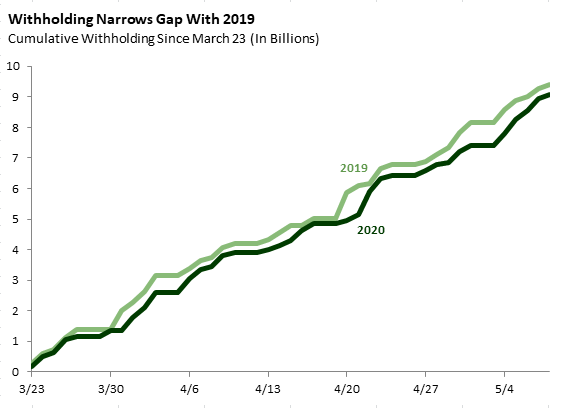Bottom Line: Income tax withholding unexpectedly surged this week, but cumulative collections since March 23 remain somewhat below last year’s level.
California employers are required to make regular income tax withholding payments for their employees, which can provide a real-time indication of the direction and magnitude of the aggregate change in the employers’ payrolls. Most withholding payments are for employees’ wages and salaries, but withholding is also due on bonuses and stock options received by employees. We caution against giving too much weight to withholding numbers in any given week because a single anomalous day can result in numbers that are difficult to interpret. Nonetheless, given the pace and possible severity of the shift in the state’s economy resulting from the COVID-19 pandemic, tracking weekly withholding is worthwhile as a way to assess the state’s rapidly changing economic situation.
The first graph compares withholding payments received this week to payments received in the comparable week in 2019, which ran from Monday, April 29 to Friday, May 3 of that year. Withholding was up 36 percent from the comparable week in 2019. Timing issues may be partly responsible for the sudden uptick: the first few days of any month typically have high collections, and this week ran from May 4 to May 8 while the comparable week last year ran from May 6 to May 10.
The second graph compares the year-over-year percent change in withholding (withholding this week relative to the same week in 2019) to weekly declines experienced in March, April, and May of 2009, when the state was in the depths of the Great Recession. The comparable week during the Great Recession was also a relatively good one, although it did not see the surge we saw this week.
The final graph shows total withholding collections since Monday March 23, when we first started to see evidence of an impact of the pandemic on withholding. As shown in the graph, total collections between March 23 and May 8 are down 3 percent ($300 million) compared to 2019. As of last week, the gap was 9 percent ($750 million).



